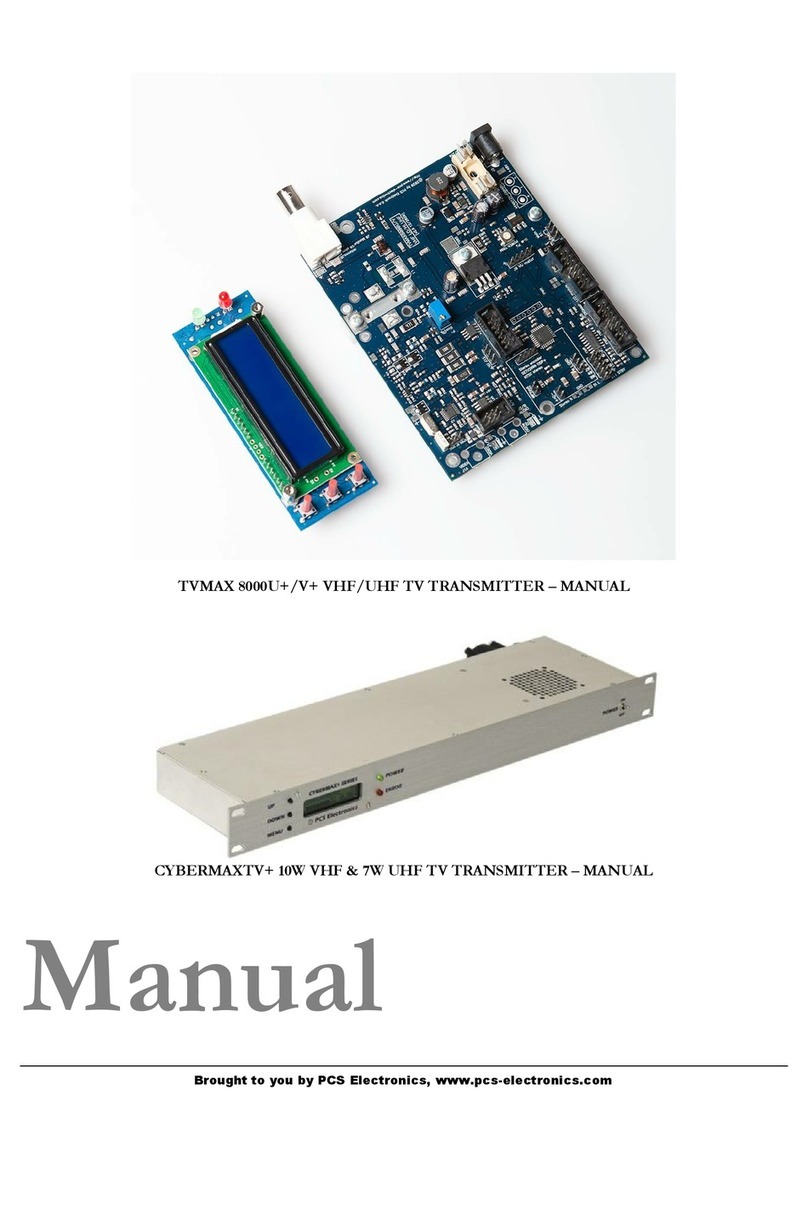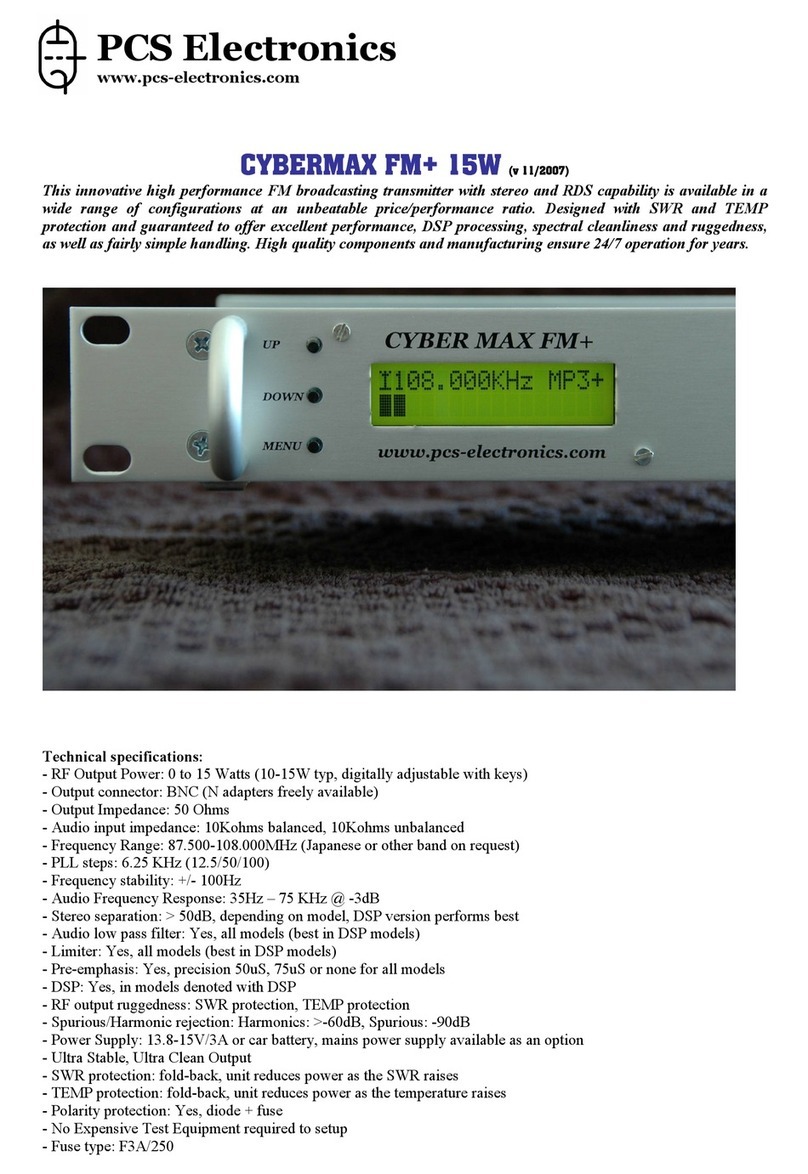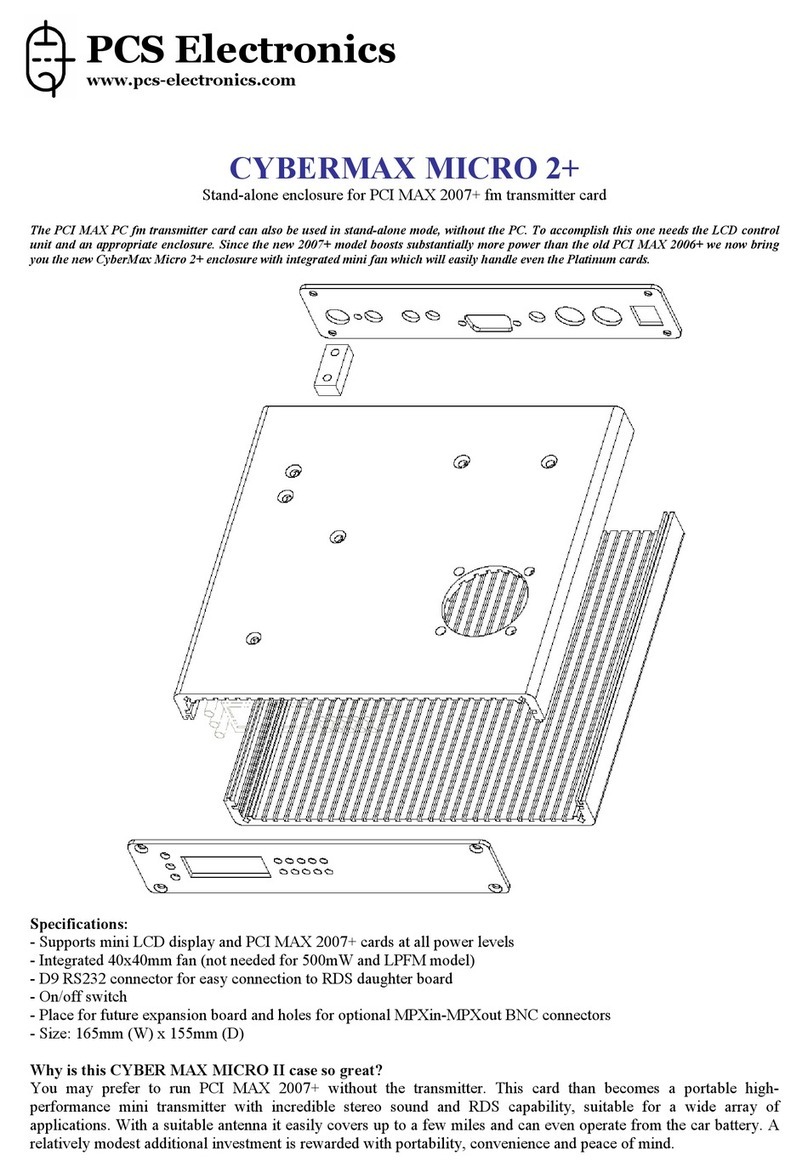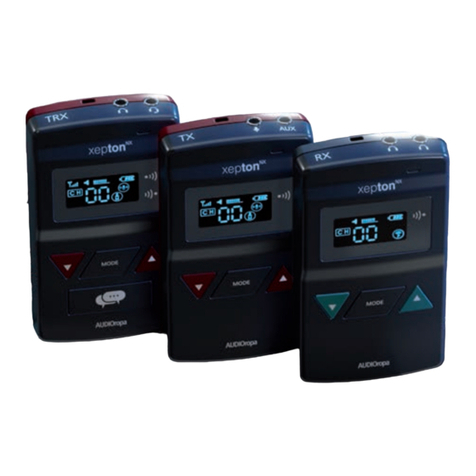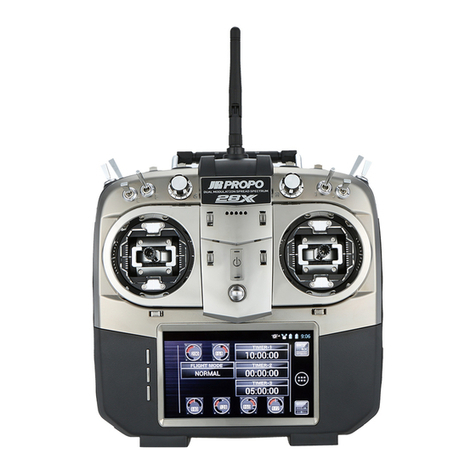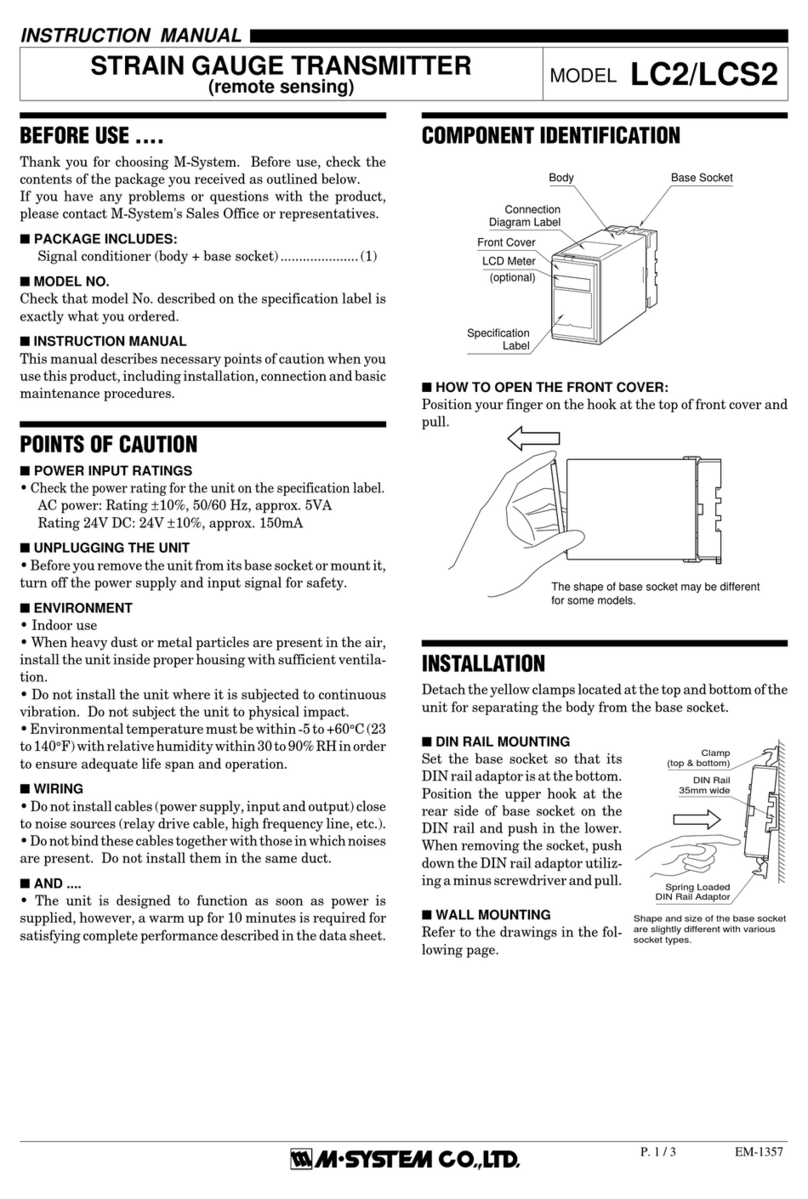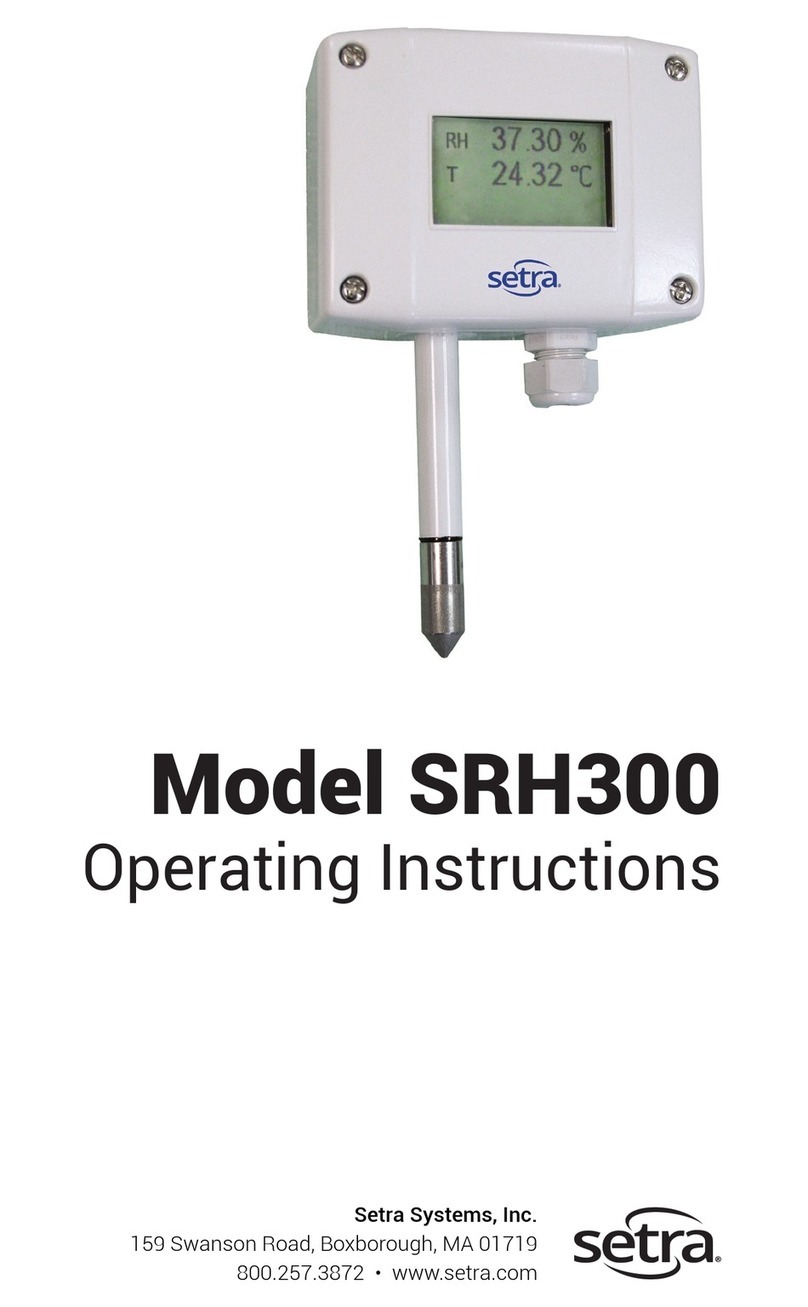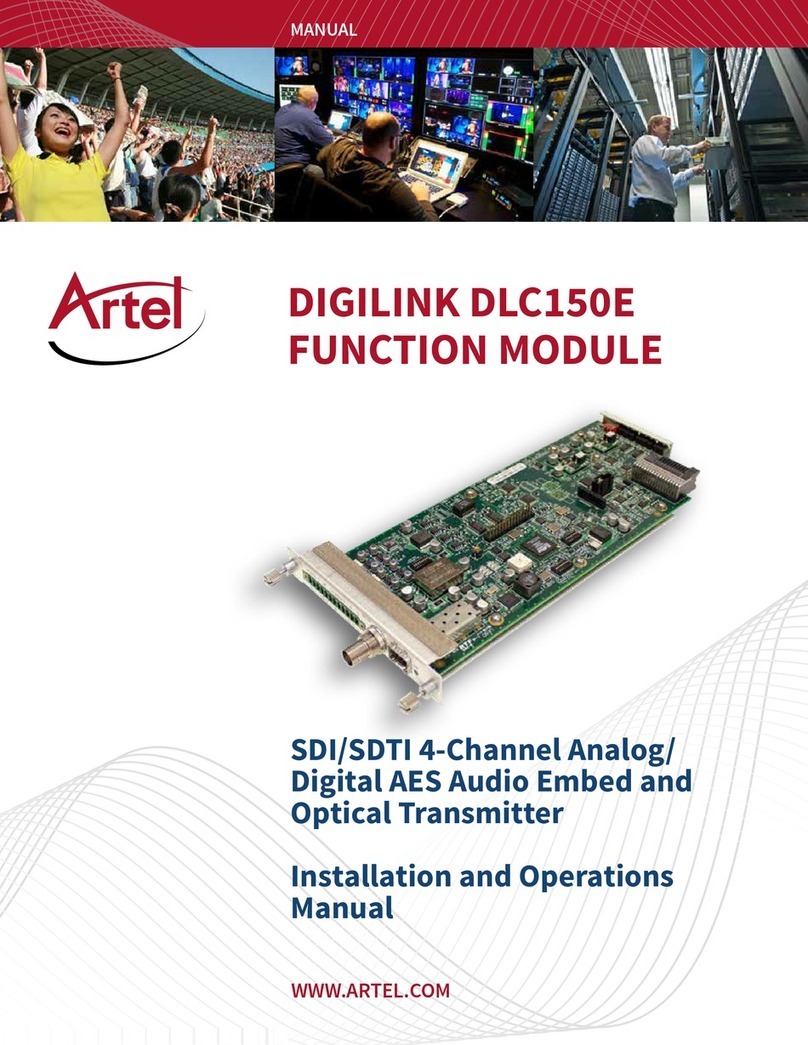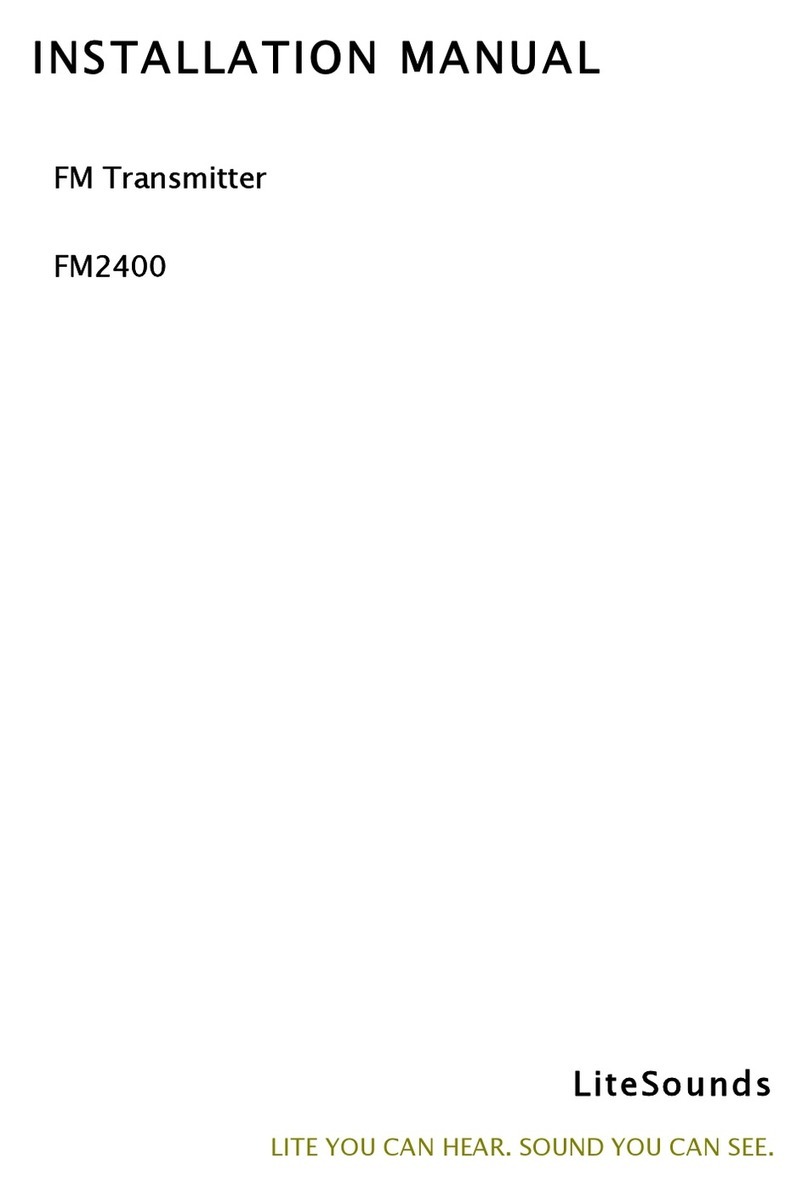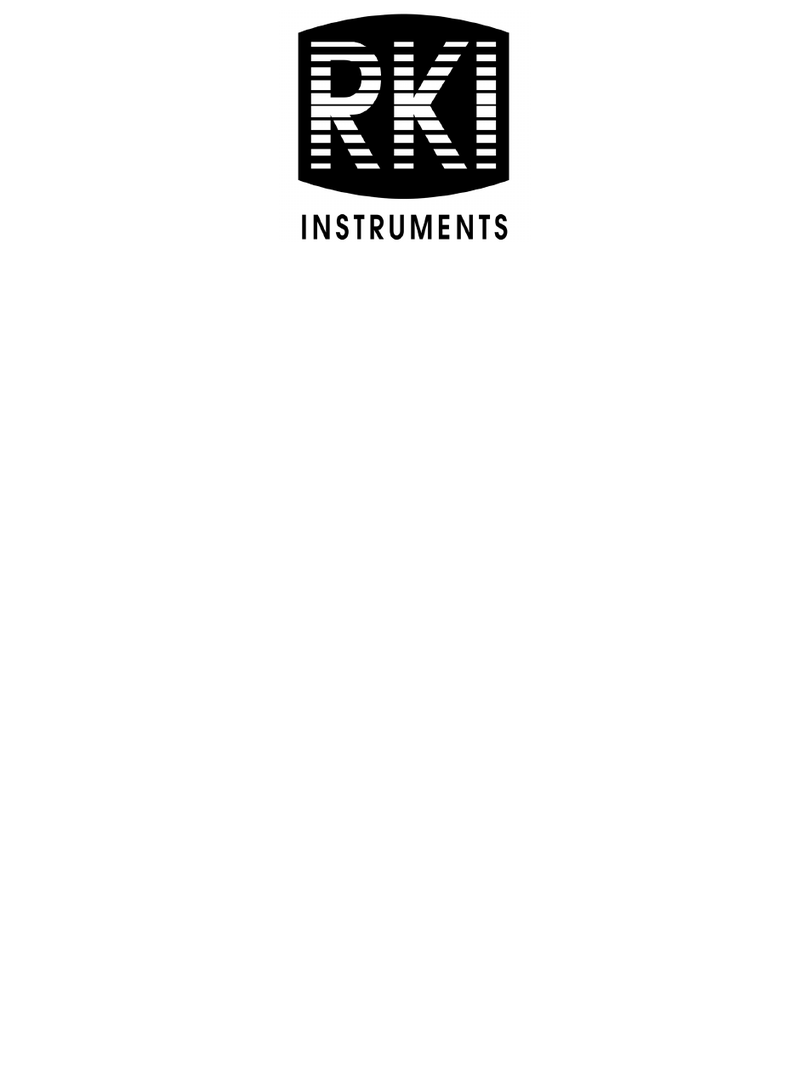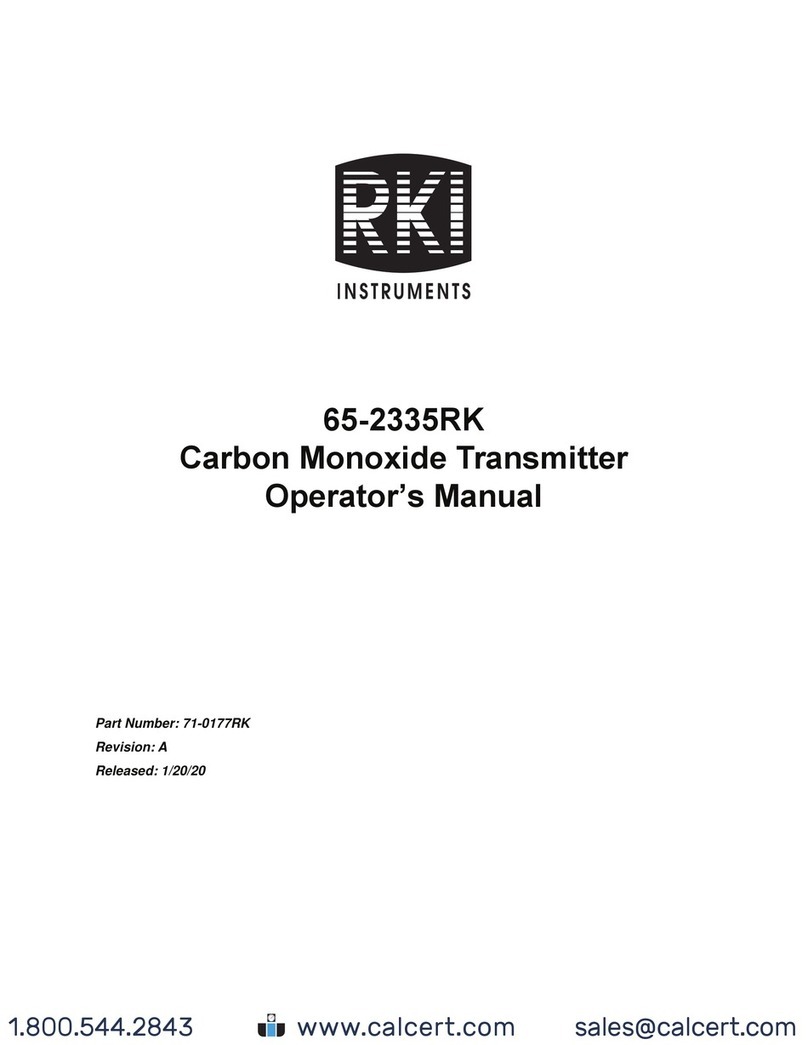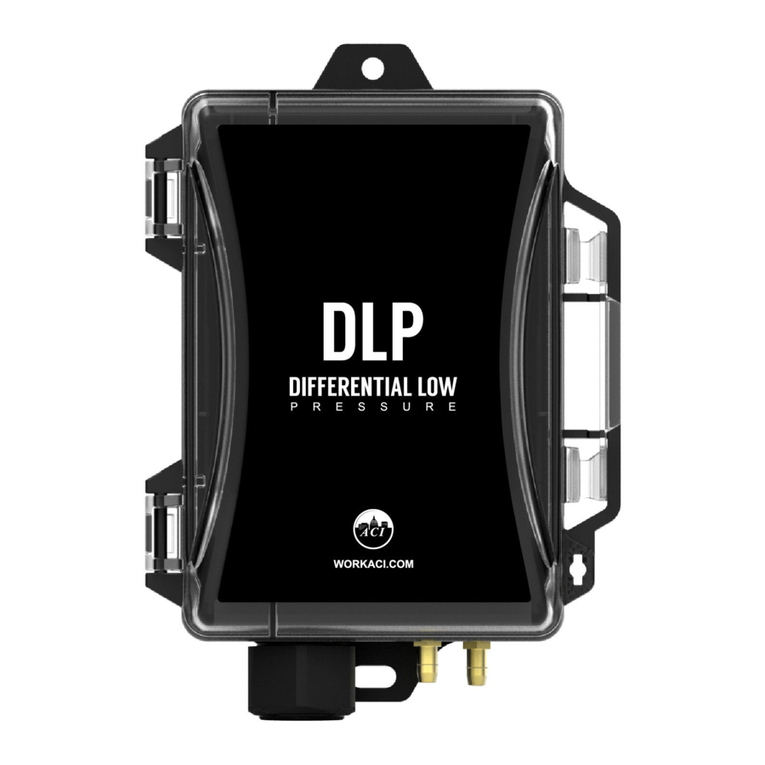PCS Electronics AMMAX8000+ User manual

Brought to you by PCS Electronics, www.pcs-electronics.com
IMP ORTANT NOTE
- Upon receiving your order inspect the packaging material and unit for apparent damage.
Any damage should be reported immediately so we can make a claim with the shipping
company. Take photos, if you can, they can be used as a proof.
- Mains cable is typically not included with our mains power supplies and units. Since these
cables vary from country to country and we had trouble finding the exact type we decided
against including them, especially since finding them is so easy and cheap locally. They
can be obtained in any radio/computer/hardware shop at the cost of about 1 US$. It is the
type used in your PC for mains power.
- Study local regulations and ensure you are always operating in compliance.
- Do not open the unit or attempt service yourself. Deadly mains voltage is present inside.
There are also high RF voltage points that can cause burns and discomfort if touched.
- Finally, never ever operate any transmitter or amplifier without a properly tuned antenna!

Brought to you by PCS Electronics, www.pcs-electronics.com
TableofContents
Introducing AMMAX series of transmitters.................................1
What makes this AM transmitter series so great?...........................1
Technical specifications:.................................................................2
Thank you for purchasing this AM transmitter.................................2
Front and back panel layout – 100W model ..............................3
Front and back panel layout – 500W/1000W/2000W................4
What’s inside the box?...............................................................6
AM Exciter board.............................................................................6
Before you start..........................................................................8
Antenna...........................................................................................8
So, what is this swr (vswr) everyone talks about?...........................9
Coaxial cable ..................................................................................9
Mains power supply and mains power cable...................................9
Audio source with mixer, microphone etc........................................9
Wiring everything together .......................................................10
Wiring things up and first power-up...............................................10
Using the CyberMaxAM+ series transmitter ............................11
Lcd control module menu system: Power and DSP functions.......11
<RF POWER> ..............................................................................11
Changing frequency......................................................................11
<VIEW SELECT>..........................................................................12
<TREBLE> and <BASS>..............................................................12
Compressor Settings.....................................................................12
<LCD CONTRAST>......................................................................13
<PLL STEP>.................................................................................14
<FIRMWARE VER>......................................................................14
Troubleshooting............................................................................14
Troubleshooting our AM transmitters.......................................15
Appendix A – Warranty and legal info......................................17
Important notice!...........................................................................17
Warranty and servicing! ................................................................17

Brought to you by PCS Electronics, www.pcs-electronics.com
Legal info ......................................................................................17
Limitation of liability.......................................................................17
Also available from www.pcs-electronics.com ..............................18
Revisions and errata ................................................................19
Index.........................................................................................20

IntroducingAMMAXseriesof transmitters
Our series of AM broadcasting radio transmitters
his manual covers our AM transmitters either as a board or built into 1H rack enclosure or 2H/3H enclosure
together with an amplifier. Please note these units are available for medium wave (MW) and short wave (SW)
bands. Additional frequency bandsmay be available so don’t be afraid to ask for anew band.
What makes this AM transmitter series so great?
While for many mentioning AM transmitters brings back childhood memories, these are still used widely in some countries.
Besides, AM can be lots of fun to play with. Long wire antennas, different signal propagation (evenworldwide), the nostalgia
that comespacked with it... well, it issomething very different in this modern age.
Our old AM MAX units sold out many years ago and for a long time we wanted to make a new AM transmitter, this time
with different, more modern approach, with better new parts and better specs. And we finally did. It is equipped with DSP
which makes it possible to control parameters of the audio chain, such as the compression, low pass audio filter cut
frequency and pre-emphasis via convenient LCD with menu system. Other features, such as the fully solid-state PWM
modulator which ensures crisp audio, 125% positive peak modulation, compact form factor, plenty of audio input options
and LCD display unitmake AMMAX8000+ really something special in this modern age.
Version in 1H 19" rack enclosure enables fast deployment in easy-to-use form factor with good shielding and ventilation.
Unit isrugged and made for 24/7/365 operation. The larger models in 2H and 3H rack can produce up to 2000W of power
and are also designed for 24/7/365 operation withregular maintenance.
Chapter
1
T

Brought to you by PCS Electronics, www.pcs-electronics.com
Technical specifications:
RF section:
- Frequency range: 540-1800KHz (MW), 5000-6000KHz (SW), 6000-7000KHz (SW), 7000-8000KHz (SW), 40m+80m
(HAM) and other bands on request
- RF Output Power: about 100W/500W/1000W/2000Wpeak topeak depending on selected band and frequency
- Output connector: BNC, 50 ohms (100W model), 7/16 female for 500W/1000W/2000W models
- PLL steps: 1KHz, DDS generated signal
- Spurious/harmonic rejection: >25dB onsome bands band >50dB (may require additional externalfilter)
- No-tune wideband amplifier design with custom built filter (for 500W/1000W/2000W)
- Power supply 100W model: 24-48V (2,5A). Use 50V for maximum output power, 2.1mm power socket, center (+),
polarity protection (diode + fuse)
- Power supply 500W/1000W/2000W models: Mains 220-240V/50Hz, will work with 110V power with some derating
- LCD display shows: Power, frequency, temperature, supply voltage, audio level
- Ambient temperature: 0° to +45°C
- External dimensions 1H rack: (W x D x H) 19" x depth (130mm) x height 1HE (44mm)
- Weight: 1kg
– External dimensions 1000W (W x D x H) 19″ x depth (492mm) x height 2HE (88mm)
– Physical weight 15Kg
– Volumetric weight up to 20Kg
– External dimensions 2000W (W x D x H) 19″ x depth (550mm) x height 3HE (132mm)
– Physical weight 25Kg
– Volumetric weight up to 30Kg
Audio section:
- Audio performance: Less than<1% distortion, 20Hz-4500Hz(adjustable bandwidthup to 7500KHzfor digital modes)
- Limiter + DSP compressor and filter
– Audio connectors exciter board only: 3-pin jumper
– Audioconnectorsfor units in a rack enclosure: BNC (single-ended input), 2x RCA, 2x balanced XLR and USB audio
– Audio level required: 4dBu (1.23Vrms @ 0db gain), -10dBu (0.316Vrms @ +14dB gain), adjustable in wide range
– Audio input impedance: 10Kohms resistive, balanced
– Pre-emphasis Flat, 50 or 75usec
Thank you for purchasing this AM transmitter
We hope you will enjoy it as much as we do andif you do remember to tell your friends and colleagues about it. Please feel
free to leave your comments at our website or post your experience in our forum. And if you encounter a problem, please
let us know so that we may improve our products, offer advice and suggestion. From all of us we wish you happy
broadcasting!
Your PCS Electronics team

Brought to you by PCS Electronics, www.pcs-electronics.com
Frontandbackpanellayout–100Wmodel
Front panel for 100W model
Reference Function
1 Three push buttons, the UP, DOWN and MENU keys.
2 LCD display that lets you control the unit and monitor various parameters.
3 The green led. Green signals power is ON.
4 Red error led. Turns on while VCO is tuning into selected frequency and in case of SWR or TEMP error.
5 Power switch in the middle of the panel is a standby switch. To really disconnect the unit from mains
power, use the main switchat the back.
Description of front panel of CyberMaxAM+ in 1H rack enclosure
Back panel for model in 1H rack
Reference Function
1 Power jack, center is positive. 40-50V DC, 2,5A
2 USB audio input (for PC)
3 Ventilation aperture, fan
4 Antenna connector,BNC. Do not operate without antenna.
5 BNC connectors for MPXin, MPXout and 19KHz pilot not needed for AM transmitter (MPXin can be
used for audio input)
6 RS232/USB for controlling your transmitter and programming RDS parameters. AMMAXdoes not have
remote controlcurrently.If you askfor this feature, we will addit.
7, 8 Audio inputs, RCA jacksfor left and right channel.
9,10 Balanced audioinputs left and right channel XLR (Canon).
11 AMMAX does not have DIGIAMP currently.
12 Optional Ethernet remote control port. AMMAX does not have remote control currently. If you ask for
this feature, we will add it.
Description of back panel of CyberMaxAM+in 1H rack enclosure
Chapter
2

Brought to you by PCS Electronics, www.pcs-electronics.com
Frontandbackpanellayout–500W/1000W/2000W
Front panel for 500W/1000W/2000W model
Reference Function
1 Rotary button.
2 LCD display that lets you control the unit and monitor various parameters.
3 The green led. Green signals power is ON.
4 Red error led. Turns on when any alarm is active.
5 Alarm LEDs for Temperature alarm, SWR (Reflected power) alarm and Over-current alarm.
6 Power switch in the middle of the panel is a standby switch. To really disconnect the unit from mains
power, use the main switchat the back.
7 LED Bar-Graph VU meter for audio
8 LED Bar-Graph VU meter for power and reflected power
9 RF sample signal for monitoring of transmitted signal
Description of front panel of CyberMaxAM+ in 2H rack enclosure

Brought to you by PCS Electronics, www.pcs-electronics.com
Back panel for 500W/1000W/2000W model
Reference Function
1 Antenna connector,7/16 female.Do not operate without antenna.
2 Main power switch for complete shut-down
3 Mains cable socket,insert mains cable type here (same type asused for PC). 2KW units don’t have this as
mains cable is wired directly.
4 Mains power supply. Pull-out and replace tyle. Usually secured in place with a small screw.
5 RF input, only used for amplifiers (not used for AM transmitters)
6 DIGIAMP interface, (not used for AM transmitters)
7 Optional Ethernet remote control port. AMMAX does not have remote control currently. If you ask for
this feature, we will add it.
8,9,10 BNC connectors for MPXin, MPXout and 19KHz pilot not needed for AM transmitter (MPXin can be
used for single-ended asymetric audio input)
11,12 USB/RS232 for remote control of transmitter. AMMAX does not have remote control currently. If you
ask for thisfeature, we will add it.
13, 15 Audio inputs, RCA jacksfor left and right channel.
16, 17 Balanced audioinputsleft and right channel XLR (Canon).
14 USB audio input (for PC)
18 MPX audio level adjustment (not usedin AMMAXtransmitters)
Description of back panel of CyberMaxAM+ in 2Hrack enclosure

Brought to you by PCS Electronics, www.pcs-electronics.com
Ref.
Function
A Connect ON/OFF switch here, but you can also just install a jumper. A LED diode can also be connected as
shown on the image, seriesresistor is on board and isnot necessary.
1 Audio input - 3-pin jumper.
2 Audioinput- 14-pin header for optional external audio input board with RCA, XRL and USB interface
3 Audioprocessing selection jumper (DSP or purely analog with minimal processing for use with DRM)
4 LCD control unit, attach your LCD control module here
5 AM PWR modulator adjustment – amplitude level
6 AM PWR modulator adjustment – carrier level
7,8 Power display adjustment trimmers, internal power meter accuracy adjustment. If the internal power display on
the LCDis a bitoff you cancorrect its accuracy with this trimmer.
9 Soldering posts for a 12V fan. Required for stable operation and long life.
10 RF output connection. BNC jack. Use a properly matched antenna. The range and success of your transmissions
will depend primarily upon the quality and position of your antenna so invest your energy and money into a
proper solution. Poor unreliable connections may damage the finaltransistor.
11 Power ON/OFF connector, install a jumper if you don’t need a switch. There is also a pin for LED diode going
to + via resistor.
12 Power supplyconnector, center is positive. DO NOTuse more than 50V.
Description of various elements of the AMMAX+ AM exciterboard

Brought to you by PCS Electronics, www.pcs-electronics.com
Beforeyou start
It is recommended that you read this section before you power your unit up for the first time. Let us clear up some basics
you should know about. You will also find some useful tips in our guides and forum at http://www.pcs-electronics.com.
Here is whatyou need to getyour AM transmitter on the air:
Antenna
We are now selling a wire antenna type that can be used to transmit at MW frequencies. Itis a relatively simple wire antenna,
and it is very long so keep this in mind. If placed high and in a great location the range can sometimes even reach tens of
kilometers. Place it as high as possible. You can even bury the grounded radial exactly under the wire antenna to enhance
performance further. Commercial stations usually have long grounded wires buried under the towers going in all directions.
Suitable DIY antennas for the AM transmitters:
We are giving you a link to several 160m HAM radio antennas. These are operating just slightly above broadcast band at
1800KHz. To make these work for MW broadcast band they will need to be slightly longer. The further you go towards
540KHz the longer antenna will need to be. The same goes for capacitors and coils in any tuning/matching networks that
are needed to bring impedance of antenna closer to 50 ohms. You can also look for 160m ham antenna designs here. Note
antenna performance is critical for AM transmitter range and it does make a HUGE difference. A good antenna will ensure
surprisingly big range with 100W, more than 20km-30km is possible. Link1, link2, link 3, link4
Once you’ve chosen and installed your antenna there is another thing to consider. You can read more about it in the next
section (So what is this SWR everyone talks about). Before powering up your transmitter on the air you should tune your
antenna to get minimal SWR. This is typically done by adjusting the position of the antenna and any adjustable pieces or
length of wire. Aim for 2:1 or less. Use low power into the antenna when tuning it up and adjusting. If you were using full
power and a bit of the antenna came off in your hand the VSWR could be so bad as to blow the final transistor. For the
same reason check the DC continuity of the antenna with an ohmmeter before plugging it in, to be sure it's what it's meant
to be,either a short circuit or an open one, depending on the antenna type. Note you won’t be reading 50 ohms with regular
ohmmeter. For instructions regarding construction of antennas please see our website: http://www.pcs-electronics.com
(guides section - antennas).
Antenna is a crucial part of the system so take special care. It is usually a good idea to place antenna away from your
transmitter, power supply and audio system. Also, any transmitter should be in a metal case which shields circuitry from the
radiation of the antenna. If you cannot meet these requirements, you could experience feedback and other RF problems. We
cannot guarantee proper operation of any transmitter/amplifier unless suitable antenna systemis usedand transmitters are in
ventilated metal enclosure! This applies to any transmitter. Interestingly, strong RF field can make CD players and other
digital devices gocrazy. Try placing antenna next to yours and see what happens. Most of the modern audio gear is not RF
shielded – reducing costs is unfortunately the mantra today. Therefore, keeping antenna awayfrom audiogearis a good idea,
too.
If you are going to place your antenna outside, on your roof, please take care of the grounding. This should be done to
prevent lightning hazard and should be done by a company specializing in lightning protection. You can read more about
lightning protection in the book recommended below or many of the websites (Google up “lightning protection ham radio”
for example).
I hope this basic introduction will not scare you too much, it should be sufficient for the time being although we encourage
you toexplore thisexciting subject further with the helpof a book suchas the ARRL Antenna Book:
http://www.amazon.com/exec/obidos/ASIN/0872598047/mightyspiraterad
Chapter
4

Brought to you by PCS Electronics, www.pcs-electronics.com
So, what is this swr (vswr) everyone talks about?
SWR is a measureof how well two devices are impedance matched to each other.Typical radio/TV transmission equipment
is designed for 50-ohm load impedance, so we usually use 50-ohm cables and build or buy antennas that are specified for 50
ohm. While most cables have flat impedance over frequency (they measure 50 ohms at all frequencies you are likely to use)
the same isnot true of the antennas.
A 1.0:1 VSWR is a perfect match. That means the load impedance is exactly 50 ohms. A 2.0:1 VSWR is obtained when the
load impedance is either 25 ohms or 100 ohms.
Because most transmitters will deliver full power with a load VSWR of up to 2.0:1, this value is usually considered the limit
for acceptable operation. Many prefer to keep their VSWR below that however, but for all practical purposes, it is
unnecessary to spend time or money trying to get much below a VSWR of 1.5:1. The benefits will be hard to measure and
even harderto notice.
On the other hand, coaxial cable losses increase rapidly, for a given frequency of operation, when the antenna VSWR
exceeds 2.0:1. This caneven, in some extreme cases, result in the coaxial cable burning, even when running 100 W. Using a
higher grade of cable will definitely improve things, but even high-quality coaxial cable becomes very lossy when VSWR
exceeds3.0:1 at higher HF frequencies (or VHF and higher).
Coaxial cable
Coaxial cable is an electrical cable consisting of a round, insulated conducting wire surrounded by a round, conducting
sheath, usually surrounded by a final insulating layer. The cable is designed to carry a high-frequency or broadband signal,
usually at radio frequencies. Coaxial Cabling is a two-conductor closed transmission medium that is often used for the
transmission of RF energy. It yields excellent performance at high frequencies and superior EMI control/shielding when
compared to other types of copper cabling. Coaxial cabling is commonly found in broadcast and networking systems. Most
coaxial cables have a characteristic impedance of either 50 or75 ohms. The RF industry uses standard type-names for coaxial
cables. The U.S military uses the RG-# or RG-#/U format (probably for "radio grade, universal", but other interpretations
exist).
The common RG-58 from Radio Shack is perfectly ok at MWfrequencies.BELDEN makes terrific coaxial cable in various
qualities and with very low loss (measured in dB’s…decibels). 3 dB loss = 1/4 of your signal strength - either lost or gained.
Watch out for the correct impedance; RG58, RG213, H-500 and H-155 have 50 Ohms, RG-59 and RG-6 have 75 Ohms.
Most antennas and transmitters including ours are 50 ohms. Check our website for good coax. Don't buy more than you
need to make the long run to your antenna and don't make up a few "jumpers" to go between your exciter, VSWR meter
and your antenna asall you'll do is create higher SWR and more line losses. H-155 from Belden is also perfectly ok at MW or
SW frequencies!
Mains power supply and mains power cable
Do not underestimate the importance of mains power supply, despite abundance of all kinds of cheap units available today
they unfortunately do not always meet requirements. What you need is a well stabilized DC 48-50V mains power supply that
can supply at least 2,5 amps of continuous current without overheating, introducing buzzing, dropping the voltage down or
acting up in other way. Whenever in doubt please buy our mains power supply. One final note, if you use less than 48V this
effectively lowersyour output power.The lower the supply voltagethe lowerthe power.
If you ordered and received our mains power supply (which is recommended) you’ll notice the mains cable is not included
but can be obtained in any radio/computer/hardware shop at the cost of about 1 US$. It is the type used in your PC for
mains power. Since these cables vary from country to country and we had trouble getting the exact type locally we decided
againstincluding them, especially since finding them is so easylocally.
Audio source with mixer, microphone etc
You need audio source to drive your transmitter. This will typically be either a computer (just plug the cable into your sound
card outputs, a mixer and a variety of audio sources, such as a microphone, CD player, DAT player, tape deck, gramophone,
MP3 player etc.

Brought to you by PCS Electronics, www.pcs-electronics.com
Wiringeverythingtogether
Wiring things up and first power-up
Wiring the CyberMaxAM+ is easy, just make sure you read the previous chapter first and setup antenna and coaxial cable
correctly. Then proceed with the following:
- Erect antenna tower andinstall antenna securely. Make sure your antenna is well away from any metal objects. Ensureyour
antenna tower is grounded securely.
- Connect one end of your 50ohm coaxial cable to the antenna. If you have SWR analyzer you cannow verify SWR of your
antenna. If your antenna is already tuned connectthe other end of coaxial cable to the antenna connector (BNC) at the back
of the transmitter. If you have SWR/POWER meter, you can wire that one inline between antenna and transmitter as well.
Make sure the SWR meter supports the frequency band required. Ensure all connectors are firmly secured and antenna is
mounted securely.
- While making sure power switch is off connect mains power cable into the mains power supply and connect mains power
supply into the back of the transmitter.
- Inspect all cables quickly again and make sure everything is secure.
- Turn ona radioreceiver and set it to your intended transmitter frequency.
- Flip the POWERswitch and wait for the unit to turn on. Now set desired frequency with the UP/DOWN keys. There is a
known software bug that may make unit reboot during tuning, wait for reboot and continue tuning. Rebooting will not
happen during normal operation. Wait a few seconds for the red LED diode to turn off and transmitter will turn on. Your
radio should now mute since you did not connectany audiosources yet.
- Observe output power.Should be about 10-20% of maximum rated power with no audio.
- You can now connect audio sources of choice and verify audio performance.
Chapt
er
5

Brought to you by PCS Electronics, www.pcs-electronics.com
UsingtheCyberMaxAM+seriestransmitter
Basically, there are three push-buttons available for the menu system; UP, DOWN and MENU. By pushing UP or
DOWN you get a shift of frequency in corresponding direction. Hold any of these keys for a few seconds and the jumps
will increase to25 KHz. The new frequency is saved automatically. The third button (MENU) gives you an option to select
and setup many of the options and DSP functions of this unit.
Lcd control module menu system: Power and DSP functions
The UP and DOWN keys are used to change parameter values. In normal mode the LCD simply shows the frequency and
power or whatever view you select. Menu key can be used to enter the menu mode, repeatedly pressing this key brings up
the following menus: <RF POWER>, <VIEW SELECT>, <TREBLE>, <BASS>, <COMPRESSION>,
<THRESHOLD>, <ATTACK>, <DECAY>, <INTEGRATION>, <LCD CONTRAST>, <AUDIO VOL>, <PLL
STEP>, <FIRMWARE VER>, <TEMP ALARM>. Pressing the UP or DOWN key selects the desired parameter and
allows you to modify its value. Another press on the MENU key and you’re back to the normal mode. Note that all these
settings except power and frequency are already set as they should be so changing them should not be necessary and is not
recommended.
<RF POWER>
RF output power cancurrently only be adjusted by changing supply voltage. The LCD display will not let you change output
power.
Changing frequency
Simply press the UP/DOWN button to change frequency. Depending on PLL STEP setting your frequency will go down
or up in selected steps. If you keep pressing a key for a while the PLL STEP switches to fast tuning mode and jumps in
larger steps.
Setting frequency,default view
Cha
pter
6

Brought to you by PCS Electronics, www.pcs-electronics.com
<VIEW SELECT>
AMMAX+ can display several various parameters. Since the LCD real-estate is limited to 2x16 characters we prepared
several pre-programmed views that only show a selected number of parameters. At the time of writing these views were
available:
- [Freq+Mode+Pwr] – This view shows frequency, mono/stereo mode and output power
- [Fr+Mode+Te+Ue] – This view shows frequency, mono/stereomode, exciter temperature and exciter supply voltage
- [Po+Pr+Uamp+Ta]– This view shows output power, reflected power, amplifier supply voltage and amplifier temperature
(if used)
- [Audio Level] – This view shows audio level bar graph. For this to work you the W solder bridge on the LCD module
needs to be closed-soldered.
- [Uptime D:H:M] – This view shows how long the transmitter has been operating without mains power going out. It is
sometimes useful in diagnosing mains power failures.
- [Auto Scroll]D – This is the default view, it shows each of the above listed views for a short while and than moves on to
the next in an endless loop. This way you can see all the relevant parameters without having to go through the menu system
to change the view type, you just have to wait a few seconds for the view tochange.
<TREBLE> and <BASS>
This option allowsyou to set the amount of TREBLE and BASSin your audio. Recommended values are markedwith (D).
Setting treble
Compressor Settings
Several MENU settings control the operation of the compressor. Let’s assume that the audio signal enters the transmitter at
some low level. Compressor does nothing to the signal until at one point as the input signal increases the signal reaches the
compression threshold. Digital signal processor startscompressing the signal beyond that point. The higher the compression
ratio the higher thecompression. For example, compression ratio of1: ∞would ineffect be a limiter.
Explanation of the compressor settings
Setting the compression level

Brought to you by PCS Electronics, www.pcs-electronics.com
Setting the compression threshold
Setting the attack time, this is the time between the input signal and the actual response of the compressor
Setting the decay time, this isthe time the compressor needs to respond after the input signal falls back to normal level (below threshold).
Setting the integration interval, this is the time the DSP evaluates the signal to establish whether it shouldrespond or not
Integration interval determines the energy needed to trip the compressor. In simple words; it determines how long the audio
needs to be loud for the compressor to respond by reducing the gain. This is not to be confused with attack time. Attack
time of 50ms means the compressor will respond in 50ms after the signal spike is detected, regardless of duration of that
spike, even if it is just a very short event. With longer integration interval, on the other hand, compressor only responds if a
long spike ora substantial number of spikes are detected (meaning more signalenergy).
<LCD CONTRAST>
Select for the best visibility. Contrast is slightly affected by ambient temperature and you can adapt it to your needs here.
Changing contrast

Brought to you by PCS Electronics, www.pcs-electronics.com
<PLL STEP>
Frequency can normally be adjusted in smallest steps of 50 KHz or larger steps of 100 KHz. We recommend you to select
100 KHz as this lets you change frequency fast and there is rarely need for fine tuning. However, you can enter this menu
and select aPLLstep of 5 KHz for example and take advantage ofthese small steps.
Changing PLL step size
<FIRMWARE VER>
This option allowsyou to display current LCD module firmware version.
<TEMP ALARM>
You can set the sensitivity of temperature alarm here. We recommend you set these to 70-80 degrees Celsius. A properly
installed unit with a tiny fan will typically run at 55 degrees C at maximum output power. This alarm applies to externally
sensed temperature if you areusing external filter or directional coupler connected via DIGIAMP.
Temperature alarm.
Troubleshooting
We hope you’ll never get to this step. We all know bad things happen but do not despair! Make sure your coaxial cable
leading to the transmitter or antenna is not shorted or open. Next check the troubleshooting table on the next page. If you
have problems, you cannot solve yourself, please see our website for contact information and support resources in our
forum.

Brought to you by PCS Electronics, www.pcs-electronics.com
PROBLEM DESCRIPTION POSSIBLE SOLUTIONS
Everything appears normal, but
there is no RF power 1. Wait a few more seconds, AMMAX+ series exciters need a few seconds to get
their power tofull
2. Maybe one of the alarms was triggered and power was reduced, try to power off
and power back on, whenever an alarm is triggered, power may be reduced until the
unit cools off.
RF outputpoweristoo low 1. Maybe one of the alarms was triggered and power was reduced, try to power off
and power back on, whenever an alarm is triggered, power may be reduced until you
power off and back on. Perhaps you adjustedTEMP ALARM too low, set it slightly
higher.
2. Transmitter may not give full power when you use a supply voltage of less than
48V. On some parts of the band power will be lower.
3. Power meter may not measure correctly when antenna connected is not perfectly
matched to 50 ohms. Check with antenna analyzer.
My power meter shows very low
power output
- Most HAM SWR/Power meters will not work well for MW band. Even types that
perform reasonably well at 160m will fail miserably at 540KHz for example.
Sensitivity of directional couplers is very much frequency dependent and usually this
means the needle is not evenmoving with power outputat100W peak.
- With AM modulation peaks and using positive modulation more than 100% (this is
done to make it sound louder and increase power efficiency) the carrier power needs
to be less than ¼ of the peak power. So, with no audio your power might be just
15W with this rising to 100W in peaks of modulation.
– The only way to accurately measure peak power (or any power at MW) is to use
dedicated power meter or oscilloscope (you can calculate power from voltage and
known load which is 50 ohms). Dedicated power meter needs to have peak power
measuring capability and must cover the MW band.
LCD display keeps showing
TEMP error warning Unit is over-heating, or your antenna is faulty. Let the unit cool off and ensure
proper cooling.Perhaps you set TEMP ALARM low, setit slightly higher.
Audio without any treble Set treble higher in LCD menu system.
Unit blows fuses and draws
excessivecurrent You have probably burned the output transistor. Overheating of antenna problems
are the most probable cause. Or lightning.
Power supplyis blinking Probably the same thing as above. Blinking power supply means its protection is
shutting it off and back on, probably due to excessive current draw caused by
burned final.
Audio distortion on high peaks,
for example on “s” sound. Your audio input level is slightly too high, reduce input audio level slightly at your
audio source. Use compressor to remove over-modulation peaks.
There is HUM in audio - Move antenna asfar away from the transmitter and audio gearas possible
- Use balanced audio inputs (XLR audio connectors) rather than RCA
- Make sure SWRislow
- Did you miss the part about metal enclosure?Put your unit inenclosure!!
- Keepaudio cables short and away from antenna and RF coaxial cable
- Form a coil from coaxial cable going to the antenna, make a few turns. This stops
RF currents that might be flowing on the outer braid of the coaxial cable. This
usually happens when you connect unbalanced cable to balanced antenna without
proper BALUN (balanced-unbalanced converter) resulting in coaxial cable
becoming part of the antenna and radiating RF energy as well…causing hum.
Troubleshooting AMMAX series AM exciter
Table of contents
Other PCS Electronics Transmitter manuals



